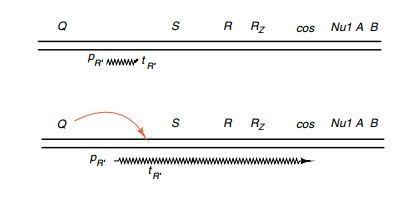Chapter: Genetics and Molecular Biology: Lambda Phage Genes and Regulatory Circuitry
Q Protein and Late Protein Synthesis
Q Protein and Late Protein Synthesis
The final genes in the early operons are the int and xis genes on the left and the Q
gene on the right. The int and xis genes are important in the lysogenization
process and are discussed in a later chapter. The Q protein functions as an
antiterminator of a promoter located immedi-ately to its right. Without Q
protein, polymerase initiates at this pro-moter and terminates 190 bases later
(Fig. 14.9). When Q protein is
Figure
14.9 Action of Q protein in preventing
premature termination attR’.

present, this termination is abolished, and
transcription proceeds across the S
and R genes, across the ligated
sticky ends, and into the remaining late genes. These code for the head and
tail structures of the phage. Since transcription of the late genes occurs at a
time when about 40 copies of the DNA exist in the cell, large quantities of
late mRNA are synthesized.
Related Topics